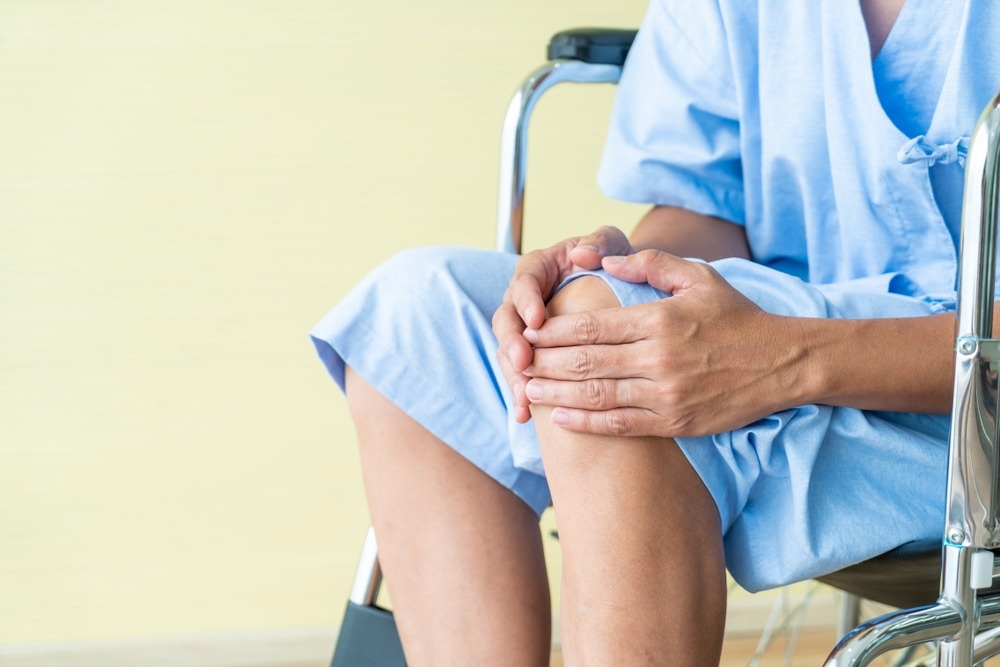
The primary disadvantage of the total joint replacement (TJR) treatment is the critical loss of skeletal muscle attached to metal joint prostheses, resulting in the formation of fibrous scar tissue, ultimately leading to motor dysfunction. Consequently, tissue engineering technology may come to the rescue in addressing this issue.
Study: Improved Muscle Regeneration into a Joint Prosthesis with Mechano-Growth Factor Loaded within Mesoporous Silica Combined with Carbon Nanotubes on a Porous Titanium Alloy. Image Credit: gowithstock/Shutterstock.com
An article published in the journal ACS Nano demonstrated the fabrication of a two-layered mechano-growth factor (MGF) carrier, an alternative isoform of insulin-like growth factor-1 (IGF-1) expressed in response to mechanical stimulation.
The two-layered MGF carrier was made of a porous titanium alloy scaffold coated with mesoporous silica nanoparticles (MSNs) and carbon nanotubes (CNTs) via electrophoretic deposition (EPD). The two-layered coating exhibited a nanostructured topology with excellent MGF loading and extended-release performance via covalent bonding.
In vivo studies on the fabricated scaffolds revealed that they preferentially promoted muscle growth than fibrotic tissue into titanium alloy structure and improved the muscle-derived mechanical properties, immunomodulation, and migration of satellite cells.
Thus, the fabricated MGF-loaded MSN and CNT-coated titanium alloy scaffolds were presented as a robust platform to restore the motor function of implanted joints like the natural joint by periprosthetic muscle regeneration.
Disadvantages of TJR Treatment and Titanium alloy in Prostheses
TJR treatment is popularly applied to replace natural joints with prostheses through arthroplasty surgery by orthopedic surgeons. However, in vivo degradation results in a shorter lifetime for these artificial joints compared to natural synovial joints. This occurs primarily because of the higher wear rates associated with artificial implant materials and the consequent adverse biological effect of the generated wear debris on bone mass/density and implant fixation.
Further, when compared to the initial TJR surgery, revision surgery of an implant is challenging, has a lower success rate, may induce additional damage to the surrounding tissues, and increases health care costs by one-third. Thus, a paradigm shift to periprosthetic muscle regeneration can increase the lifetime of prostheses.
Motor dysfunction due to the connection loss between prostheses and muscle tissue is a common complaint of patients after TJR. Thus, the periprosthetic muscle regeneration into prostheses can help to regain normal joint motor function.
Titanium alloy is considered the best solution to address the above concerns and can match both the aesthetic and the functional requirements guaranteed by the implant. Titanium alloy exhibits low values of Young’s modulus and offers a wide span of properties.
Improved Periprosthetic Muscle Regeneration
MSNs have adjustable pore diameter, high surface area, large pore volume, and excellent biocompatibility and hence stand as promising candidates to deliver therapeutic agents. However, a few studies based on MSN-coated porous titanium alloy scaffolds mentioned the brittleness of MSNs. On the other hand, CNTs have high strength and elastic modulus compared to other reinforcement fibers.
In the present work, CNTs were incorporated into MSNs as reinforcement fibers to relieve the strain between titanium alloy and MSNs. Integrating CNTs and MSNs into titanium alloy improved biomechanical behavior and imparted a sufficient biomolecule-loading capacity.
In the present work, a three-dimensionally (3D) printed porous titanium alloy was coated with a CNT-MSN layer via the EPD method, followed by loading of MGF into MSNs via covalent bonding with the help of 1-ethyl-3-(3- dimethylaminopropyl) carbodiimide hydrochloride (EDC) and N-hydroxysuccinimide (NHS). This helped achieve a long-term, slow release in prepared scaffolds.
Furthermore, the periprosthetic muscle regeneration into the prepared [email protected] coated titanium alloy scaffold was evaluated by conducting in vivo and in vitro studies. The results revealed an increased expression of myogenic genes and proteins, enhancing myoblast differentiation without biotoxicity, leading to the formation of myotubes and skeletal muscle fibers, indicating the potential of a prepared scaffold for periprosthetic muscle regeneration.
Additionally, the [email protected] coated titanium alloy scaffold activated the biological mechanism that induced the myoblast differentiation through the Akt/mTOR signaling pathway, indicated by the expression of Akt/mTOR signal-related proteins. Thus, proving the potential of MGF in serving as a local cell growth factor.
Conclusion
In summary, the two-layered MGF carrier that maintained a long-term release was composed of an inner CNT buffer layer and an outer [email protected] functional layer in the porous titanium alloy scaffold and was deposited using the EPD method.
The designed [email protected] porous titanium alloy scaffold enhanced the myoblast differentiation compared to the traditional prosthesis, without cytotoxicity, by increasing the expression of myogenic proteins and genes, forming myotubes and skeletal muscle fibers in vivo and in vitro.
The periprosthetic muscle regeneration into prostheses is needed to regain normal joint motor function. The scaffold fabricated in the present work was presented as a promising nanomaterial-based platform for periprosthetic muscle tissue regeneration into prostheses during recovery to regain normal joint motor function.
Examining the biomechanism of myogenesis gave insights into the ability of titanium alloy based on the [email protected] scaffold in activating the Akt/mTOR signaling pathway, promoting myoblast differentiation.
Reference
Wei, X et al. (2022). Improved Muscle Regeneration into a Joint Prosthesis with Mechano-Growth Factor Loaded within Mesoporous Silica Combined with Carbon Nanotubes on a Porous Titanium Alloy. ACS Nano. https://pubs.acs.org/doi/10.1021/acsnano.2c04591